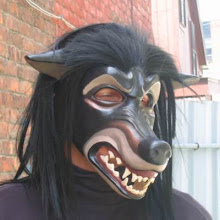First, I liberally apply Vaseline to the sculpture as a release agent. Then I mix Celluclay (a kind of commerial paper mache pulp) and roll it out into approximately 1/8" thick sheets between two pieces of wax paper. These I put into the freezer for 8 minutes to make them less sticky and easier to work with, and then I peel the wax paper off and apply the sheets over my sculpture. I blend the edges of the sheets together and smooth out any major lumps, but otherwise I don't fuss too much over the texture. It's much easier to deal with after the Celluclay is dry.
The cast will need to be cut into pieces in order to remove it from the original sculpture. After I apply all the Celluclay, I make score marks along the parting lines with a clay tool. Otherwise, the Celluclay would be very difficult to cut apart when it is dry.
Then I set the mask in front of a fan to dry. Usually after an hour or two the Celluclay will start to feel leathery and I'll be able to add a little more detail back in with a wooden clay tool. After a day or two it is usually dry enough to remove from the sculpture.
Here's the beginnings of the cast, with the score lines pressed in:
Here's the cast with one of the pieces removed and the original sculpture showing underneath:
Here's all three pieces removed from the sculpture, ready for assembly:
At this point speed is of the essence. I reassemble the pieces as quickly as possible, as if I leave them for any time they will warp out of shape and not fit together well. I make holes along the edges of the pieces, lining them up with each other on either side of the seams. If the pieces are still a little damp I can make the holes with a bamboo skewer, if they've dried more thoroughly I'll need to use a drill.
Then I tie the pieces together using twist ties (I save these compulsively) and apply glue all along the seams:
I dry the cast on a wig stand or stuff it with wadded up newspaper to help it keep its shape. Then I fill in the seams and any thin spots with more Celluclay and let it dry again.
After I've gotten a sturdy shell on which to build, I begin to add texture and refine detail, both by adding back on with wet Celluclay or by carving with a Dremel. Here's the rabbit mask with the beginnings of hair texture, created by adding a thin layer of wet Celluclay and working it with a wooden clay tool:
Here's the mask hairier and more refined. The brown marks around the eyes are scorch marks from the Dremel.
Hairier and more refined still:
Then painted and finished! The Celluclay will need to be sealed before it is painted, as it will absorb humidity and warp like a son of a gun otherwise. I brush on a layer, inside and out, of slightly diluted Weldbond (a kind of waterproof PVA glue) to do this.
As you can see, in a positive cast, much of the original sculpture's surface detail (hair, wrinkles, etc) is lost and needs to be added back in. How much detail is lost depends on the material used- a lot with Celluclay, but less with leather and other types of paper mache. In a negative cast, surface detail is preserved by the mold. This is the major reason why I use molds to reproduce most of my masks. However the fur texture on this mask is fun to create by hand, and I play with the original rabbit sculpture a little every time I make a new positive cast, mostly tweaking its fit. Positive casting also allows me to go more quickly from an original sculpture to a wearable mask, since there isn't the intermediary step of having the mold made. Plus, it's always good to have more than one tool in the tool box!

No comments:
Post a Comment